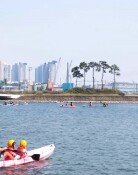Typhoon Ewiniar Hits Korean Peninsula
Typhoon Ewiniar hit the entire Korean peninsula on Monday, July 10 with its heavy rains and strong winds, bringing massive damage across the country.
The typhoon passed over to the East Sea early morning on July 11 but contrary to original forecasts, it changed direction to the right, causing much damage to the Yeongnam, Honam and Chungcheong regions.
Korea Meteorological Administration announced on July 10, Ewiniar passed through the area 60 kilometers south-southwest of Gunsan as of 3:00 p.m. July 10, and quickly headed towards north at a speed of 35 kilometers per hour. The typhoon brought heavy rains and left the country by the coast 50 kilometers north of Sokcho, Gangwon Province at 3:00 a.m. in the morning on July 11.
Unlike the forecasts that Ewiniar will enter the West Sea, the typhoon approached the southern coast of South Jeolla Province around 10:50 a.m. on July 10, somewhat weakening but still remaining a middle-sized typhoon with an atmospheric pressure of 985 hectopascals and a maximum wind speed of 23 meters per second (83 kilometers per hour).
In particular, due to the change in the typhoons course, southern areas of the country and Chungcheong and east coast regions were affected by heavy rain while the midwest regions were damaged from strong winds.
As of 4:00 p.m. July 10, most of the areas in South Gyeongsang Province had over 200 millimeters of rain, including 263mm in Namhae, 251mm in Geoje, 226mm in Sancheong and 203mm in Jinju. South Jeolla Province had rains over 165mm and Jangheung 153mm.
There are still concerns for more damage due to the rain as Yeongnam, Honam, Chungcheong and Gangweon regions and Ulleungdo and Dokdo are expected to have up to 60 to 100mm (over 150mm in places with heavy rainfall) more rain, Seoul, Gyeonggi Province and Jeju Island 20 to 80mm more, and 10 to 40mm more in the five islands in the west sea until the night of July 11 after Ewiniar leaves the country.
As of Monday, five people were killed and one missing in the southern region due to heavy rain and strong winds, according to the Central Disaster and Safety Countermeasure Headquarters. However, traffic accidents from wet roads were not included in this total and the number of victims is expected to increase.
Two hundred and ninety-seven elementary and middle schools in Jeju, South Gyeongsang and South Jeolla regions closed temporarily. Public facilities were damaged as roads and embankments were destroyed and water supplies washed away.
According to the National Emergency Management Agency, some 43 homes and 2,240 hectares of farmland were flooded of which 2,100 hectares were of the South Gyeongsang region as of 4:00 p.m. that day.
An official of the Central Disaster and Safety Countermeasure Headquarters said, The typhoon may have weakened as it left by the east coast early in the morning on July 11, but since it brought heavy rains and strong winds, we cannot ease our tension until it disappears completely.
gaea@donga.com







